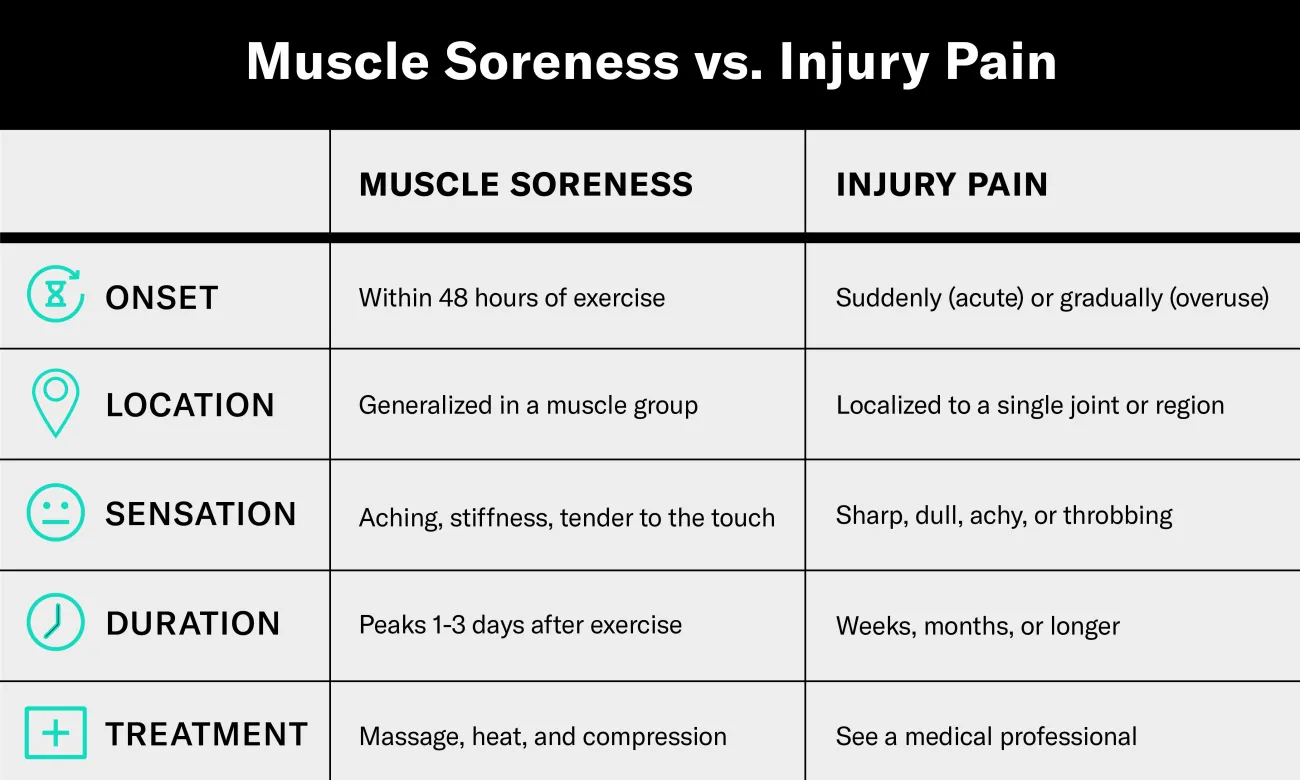Figure out the cause of your aches so you can find the right treatment and stay off the injured list.

When you’re regularly pushing yourself in workouts, you can expect some occasional muscle soreness . This tight, aching feeling can be uncomfortable, but it’s usually only temporary and goes away on its own. Pain from a joint, tendon, or muscle injury, on the other hand, may require specific treatment and might worsen if you ignore the signals and continue to exercise.
Knowing if you should worry about muscle pain isn’t always easy, though, especially because soreness and pain from injury may feel similar and the symptoms of each vary between individuals.
“Everyone has their own experience of pain,” says Alison McGinnis PT, DPT, FAFS, and clinical director of Finish Line Physical Therapy . “It’s important to listen to your body and to learn what feels normal versus abnormal for your own reactions to exercise.”
While a medical professional can give you a definite diagnosis and treatment plan, here, McGinnis outlines general tips on how to differentiate soreness vs. pain from injury to help you figure out what’s causing your discomfort.
Soreness vs. Pain From Injury: Common Causes
Stressing your body in a new way, such as starting an exercise routine or lifting heavier weights, causes micro-tears in your muscle fibers . These small muscle injuries trigger an inflammatory response as your body works to repair the trauma. The resulting swelling and soreness are signs that your body is rebuilding muscle fibers so they can become stronger and prepared for more stress in the future.
While soreness has a clear root, injury pain can stem from a number of causes. An acute injury, such as a pulled muscle or sprained ankle, may occur suddenly after an awkward movement or exercising with poor mechanics. Chronic or overuse injuries, including patellar tendonitis (knee injury) or plantar fasciitis (heel pain common in runners), come on gradually after frequent, repetitive movement. It’s best to seek out a doctor or physical therapist who can diagnose an injury and help figure out its cause.
Soreness vs. Pain from Injury: How to Tell the Difference
Because there’s some overlap in how injury pain and soreness present in the body, it’s tough to tell the difference by describing the sensation alone. As you get more experienced with exercise, you’ll gain a better understanding of what’s normal for you post-workout.
“Everyone should take the time to listen to their own body and get to know what different sensations feel like to them,” says McGinnis.
Although muscle soreness usually feels exactly how it sounds—a tender, aching, tightness in a muscle group you’ve recently exerted—McGinnis says injury pain may also feel sharp, dull, achy, throbbing, or tingling.
“Injury pain is dependent on many factors and isn’t consistent from injury to injury or person to person,” she says.
Another way to distinguish soreness vs. pain from injury is to think back to when your pain first occurred.
“Acute injuries can happen immediately during exercise, or build up gradually over days, weeks, or months in the case of overuse injuries,” says McGinnis. “Soreness rarely occurs during an exercise, with the onset usually beginning within a few hours or up to 48 hours after an intense workout.”
Also, pay attention to how long your discomfort lasts. “Muscle soreness typically lingers for a few days max,” says McGinnis. “Injury pain can last indefinitely and may come and go or stay constant.” If your symptoms remain after a week, she recommends visiting a doctor or physical therapist.
The location of your discomfort may be another clue. McGinnis explains that muscle soreness will feel generalized or spread within a muscle group or body region while injury pain can be more localized to a joint or specific area.
Muscle soreness and pain from injury often respond differently to movement. When it comes to soreness, McGinnis says “motion is lotion.” Although excessive stretching might intensify the pain of sore muscles, she explains that soreness shouldn’t be debilitating and gentle movement should make it feel better, not worse. It’s more likely you’re dealing with an injury if your pain intensifies with movement or when you put weight on the bone, joint, or muscle.

Treating Soreness vs. Pain from Injury
Although soreness will fade within a few days in most cases, there are some methods you can try to speed up relief. “Soft tissue mobilization—massage or foam rolling —heat, movement, and compression are all great options to help you feel better and speed up recovery time,” says McGinnis.
If none of these treatments are working or your pain persists longer than a week, it’s may mean you’re dealing with an injury. A medical professional will be able to give you a personalized recovery plan to get you back up and moving.
Any type of discomfort can be frustrating when you’re chasing your goals, but taking the time to determine the source of your pain will keep you healthy in the long run so you can keep achieving big results.


